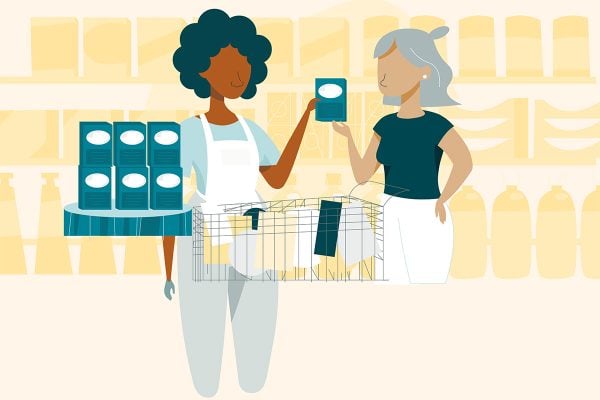 Following the news that eBay are to expand their collection points with 2,500 new locations before Black Friday, this is a guest post considering how Click and Collect is evolving, what consumers want and how it impacts online retailers, written by Matthew Robertson, Co-CEO of NetDespatch.
Following the news that eBay are to expand their collection points with 2,500 new locations before Black Friday, this is a guest post considering how Click and Collect is evolving, what consumers want and how it impacts online retailers, written by Matthew Robertson, Co-CEO of NetDespatch.
I read a fascinating article last year which proclaimed that click and collect had fully evolved. It referenced that 76% of online shoppers would be using the facility in 2017 and ‘whilst commercial space travel might still be a pipedream, consumers were most definitely racing to pick up their online orders in person’. One could have been forgiven for thinking it was safe to ‘pack up and go home’ as it was clearly mission accomplished as far as click and collect was concerned, however, the initiated amongst us will be all too aware that this is most definitely not the case.
The truth of the matter is, click and collect is constantly changing and evolving as retailers continue to innovate and re-examine what retail shopping of the future is going to look like.
In the past, click and collect was fairly straightforward. Consumers would browse their favourite retail chain online, order a specific product and have it waiting for them to pick up in store in a few hours. It was convenient for the consumer as it saved them from waiting for potentially two to four days for the item to be delivered, which was important if the item was a gift or urgent. The introduction of click and collect was also great for the retailer as it afforded them the opportunity to make an additional sale when the consumer came in-store to collect their item, in fact, some reports have found that around three quarters of consumers made additional purchases when picking up a click and collect order.
However, as with all things, innovation and constant re-evaluation is the way to stay ahead of the game and click and collect has evolved into an entirely different animal. While the concept may remain the same and the name still hold true, there have been improvements, upgrades and further developments that have been made. With that in mind, here are three key trends that will influence click and collect this year.
1. Collection of parcels at third party locations will grow
We’ve seen click and collect via third party locations grow three-fold in volume over the last two consecutive years. We expect that growth rate to slow slightly in 2018, with the market growing at 130% year on year. This increase exceeds recent predictions by the IMRG Delivery Index.
The basis for this is the increasing number of third-party click and collect providers and locations, combined with increasing adoption of third-party click and collect at online checkouts of retailers and consumer demand as a result of fewer people being “home” during the day.
Workplace and city policies such as those put forward by the London Assembly to ban personal deliveries to workplaces to reduce congestion will also drive greater volume to third-party click and collect points. We believe the impact of this has not been fully considered in previous predictions, however a mandated behaviour change of this nature could be a significant tipping point for third-party click and collect volume in 2018.
2. Retailers will start to price click and collect at third party locations more cheaply than home delivery
Historically, retailers have made collections from a third party click and collect location more expensive than home delivery. This is because carriers have had to factor in a carriage fee and a commission fee payable to the concession host, but carriers haven’t typically passed on the benefits of consolidation to retailers.
Recently, retailers like Next, Shoeaholics and La Redoute have taken a market-changing approach and priced third party click and collect at a cheaper rate than home delivery. In Next’s case, this is one of the first signs of a major UK retailer passing on the significant consolidation benefits of third party click and collect straight onto the consumer.
With retailers coming under greater margin pressure, there are few areas with as much margin gaining potential as offered by consolidating deliveries to third party click and collect locations. The significant efficiencies offered to retailers and carriers by consolidation, will compel more retailers to take this approach, driving a marked shift in volume away from home delivery in 2018.
3. In-store collect will require investment or face slowing growth rates
In-store click and collect has been extraordinarily successful, with many multi-channel retailers reporting upwards of 30% of all online orders being collected in-store. This nearly doubles amongst market leaders like John Lewis and M&S which have reported upwards of 50%. However, retailers will struggle to see the same level of growth in 2018 if they don’t invest in the channel.
The reason for this is that consumers are becoming more discerning in the experience they expect from click and collect. Research from JDA has found that 73% of shoppers would switch retailers if they had a poor experience with an online click and collect order.
Putting click and collect in a remote corner of the store and having to wait while store teams rifle through poorly formatted and organised storage rooms to find parcels, just doesn’t wash with today’s attuned click and collect shopper. This requires investment in the technology and customer experience to make sure retailers don’t lose out to other retailers offering a slicker in-store experience, or third party networks offering a more convenient experience.
Additionally, more and more retailers are having to reflect the cost of in-store click and collect in their pricing to customers as the benefit of footfall does not always outweigh the fulfilment cost for in-store click and collect. Tesco, John Lewis and New Look have all taken steps in this regard.
This increased cost to the consumer, be it by ascribing a minimum basket value to free in-store click and collect or adding on a shipping cost to the service, will soften the pace of consumer adoption of in-store click and collect, an impact that will be exacerbated where the experience isn’t up to scratch.
Click and collect will no doubt increase in popularity in 2018, with retailers of all sizes, looking to make the most of the click and collect delivery method. With huge shifts likely to appear beyond the means of ‘normal’ collection points like shops, through to places likes stations, service stations and even schools and community centres.
As consumers begin to expect more from ecommerce stores in terms of a more convenient and reliable delivery experience, it’s likely more retailers will look to offer click and collect to fulfil customer needs, helping increase sales and building customer relationship, loyalty and happiness along the way.








